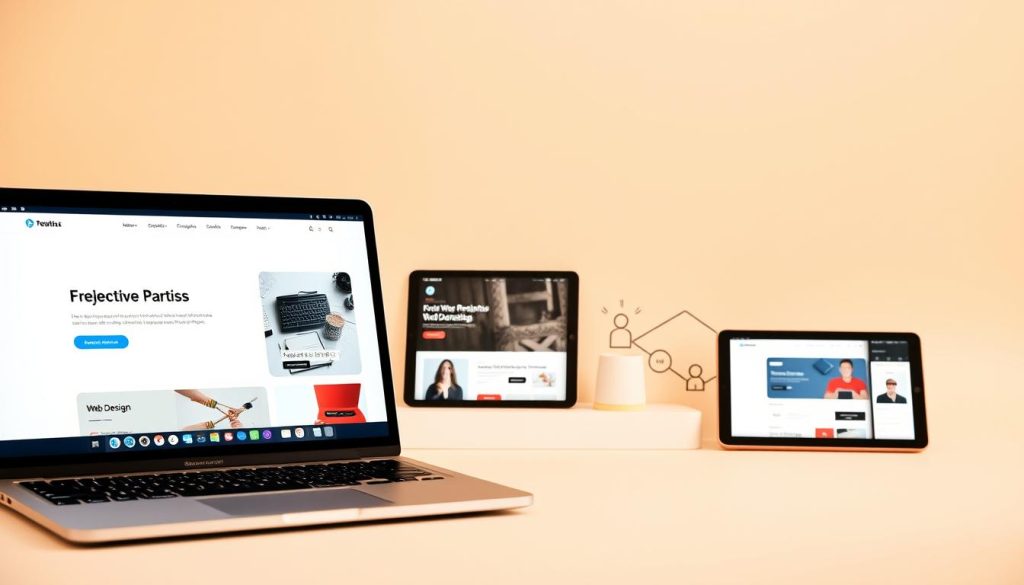Launch sites that load fast, protect user data, and run without downtime. This guide shows how a web developer can help French small businesses get online with confidence. It blends technical skills and business sense so you ship outcomes—not just code.
We cover a clear roadmap: pick a niche, build a standout portfolio, and turn conversations into paying clients. Practical tips include choosing stacks like React, Node, and Tailwind to deliver speedy frontends and stable backends.
Early traction often starts with local projects, community networking, and smart pricing. Use simple tools—task boards, time trackers, and invoicing—to keep deliveries on time. Always sign a contract that sets scope, milestones, and payment terms to avoid misunderstandings.
This is a hands-on how-to for new and seasoned developers in France who want better clients, steady project flow, and a sustainable career. Expect practical steps you can apply right away to build momentum.
Table of Contents
Key Takeaways
- Focus on fast, secure, and reliable outcomes for small businesses.
- Showcase GitHub repos, live demos, and concise case notes to build trust.
- Pick modern stacks (React, Node, Tailwind) that match project needs.
- Seed testimonials with local or low-fee projects to gain referrals.
- Use clear scopes, milestones, and contracts to ensure reliable delivery.
How to Use This Guide to Launch and Grow a Freelance Web Development Career
Start by treating this guide as a practical playbook you can act on one small step at a time. Skim the full article to see the overall process, then choose a single task to complete this week.
Plan simple blocks of time for portfolio updates, outreach, and learning. Small, consistent actions beat sporadic bursts.
Follow this concise sequence: pick a niche, build proof projects, publish a clean portfolio, hold discovery chats, and close clients with clear offers. Use Trello or Asana to track stages and FreshBooks for invoicing.
Measure meaningful outcomes: conversations booked, proposals sent, and projects closed. Avoid chasing vanity metrics.
- Update one project page per week.
- Schedule two discovery calls and follow up for testimonials.
- Switch from hourly to value-based packages as you gain traction.
| Step | Action | Tool | Time |
|---|---|---|---|
| 1: Niche | Choose demand-aligned focus (Shopify, WordPress) | Market research, Firebase | 1–2 weeks |
| 2: Proofs | Build 2 live mini-projects | GitHub, Vercel | 2–4 weeks |
| 3: Clients | Network locally and online; run discovery calls | Discord, LinkedIn | Ongoing |
freelance web development
Trust wins early work more often than long résumés. New builders get traction by showing up where local business owners meet and by solving one small, clear problem fast.

Why trust beats experience when you’re starting out
Clients pick someone they believe will deliver, even if that person lacks long experience. A quick proof-of-concept demo often proves capability better than a long CV.
Be punctual, follow up, and offer clear next steps. These simple habits create trust signals that compound over time.
Choosing the right ideal client and avoiding zero-sum competition
Define a tight niche—example: French SMB retailers on Shopify. Targeting a clear group avoids head-to-head fights with large agencies and mirror hiring filters.
- Show up where clients gather: local commerce chambers, Reddit threads, and sector meetups.
- Offer a low-risk first engagement: a short audit or a 30-minute prototype that fixes one pain point.
- Frame value in business terms: leads, bookings, and sales—not technical jargon.
- Keep a log of trust assets: POCs, short case notes, and testimonials to reuse in outreach.
Build the Right Skill Set and Pick a Niche That Clients Actually Pay For
Choose a compact skill set that maps to client demand and you’ll land paid work faster.
Start with a focused stack: HTML, CSS, JavaScript, React, Node, and Tailwind cover most fast sites and simple apps.
Pick niches that buy ongoing work
For French SMBs, practical offers sell: fast brochure sites, Shopify storefronts, and maintenance plans that keep content fresh.
Proof-of-concept mini builds
Create tiny demos that mirror a real pain—speed tweaks, a checkout UX fix, or a product card widget. A short demo wins trust faster than promises.
- Show your code: publish small repos and snippets on GitHub or Dev.to so clients see quality and process.
- Reuse components: contact forms, pricing tables, and product cards speed delivery across projects.
- Document choices: short notes on why Tailwind or Node were chosen help clients understand tradeoffs.
Specializing simplifies sales. It makes your offer clear and your delivery faster. You can expand once demand is steady.
Learn more about becoming a focused practitioner here: becoming freelance web.
Create an Online Presence That Converts: Portfolio, Code, and Credibility
An effective portfolio does more than look good—it proves you solve real problems. Build a streamlined site that highlights outcomes, not features. Keep pages lean so load times stay low and visitors stay engaged.

Your portfolio site: simple, fast, and focused on outcomes
Make sure your homepage shows 2–4 strong projects with short result bullets (faster load, more leads, higher conversions).
Show your work: GitHub repos, live demos, and case-style writeups
Include links to live demos and GitHub so potential clients can verify code and structure. Use concise case notes: problem, approach, stack, and measurable result.
Early traction: low-fee or pro bono projects for local businesses
Offer a few reduced-fee builds to local shops in France. Trade discounted work for real testimonials and local references.
Amplify visibility: LinkedIn, Dev.to, YouTube, and community contributions
Post short tutorials and mini-demos weekly. Share articles on Dev.to and clips on YouTube. Engage in Discord and Stack Overflow to grow credibility as a web developer.
« Show outcomes first, tech second — let case stories do the selling. »
- Standardize project pages: problem, solution, tools, timeline, results.
- Keep a simple contact form and calendar link to speed conversion.
- Update your portfolio quarterly and retire weaker entries.
Find Clients Through Conversations, Communities, and Referrals
A steady flow of projects starts with showing up to places where business owners actually meet. Be consistent: attend events, join local groups, and answer questions in forums so people learn your name.
Go where clients gather: meetups, industry watering holes, and local events
Identify the places in France where potential clients spend time: chambers of commerce, retail associations, and tech meetups. Visit regularly and offer short, useful tips.
From cold to closed: discovery chats that reveal solvable problems
Start conversations with a friendly opener and ask focused questions about outcomes and timelines. Listen more than you pitch.
Structure discovery calls around three things: outcome, timeline, and budget. Take notes and turn them into a simple proposal that shows how you will solve problems directly.
Referrals on repeat: deliver, ask, and systemize testimonials
After a successful delivery, ask for a short testimonial and one referral. Make it easy: offer a sample text they can approve.
Keep a simple CRM or spreadsheet with contact, last touch, and next action so leads don’t go cold.
- Offer a small paid audit or proof-of-concept to lower risk and prove value.
- Share helpful checklists and mini case studies in community channels when allowed.
- Speak at local events or run office hours to build trust and visibility.
| Action | Where to do it | Why it works |
|---|---|---|
| Attend local meetups | Chamber of Commerce, industry events | Face-to-face trust and immediate conversations |
| Answer questions in forums | Reddit, Discord, LinkedIn groups | Build reputation and attract inbound inquiries |
| Offer proof-of-concept | Discovery calls or small paid audits | Converts cold leads by showing practical results |
| Request testimonials | Post-delivery follow-up | Generates referrals and social proof |
For more tips on growing your network and turning talks into clients, see this guide on building professional relationships: develop your networking.
Price for Value and Offer Clear Packages Clients Understand
Price on outcomes, not hours, to make proposals simple and persuasive.
Value-based pricing reframes cost around measurable results. This helps small business owners see ROI instead of time sheets. Offer three clear tiers so potential clients compare at a glance.
From hourly rates to ROI-based packages
Move from hourly billing to project-based offers tied to leads, sales, or bookings. Use anchors like “From €X” for transparency and to speed decisions. Give a short, clear proposal after discovery so buyers act faster.
Tiered offers: landing page, growth site, e-commerce add-ons
Provide a starter landing page, a growth site with CMS and analytics, and e-commerce add-ons (Shopify integrations, payment setup). Make sure each package lists scope, timeline, deliverables, revisions, and post-launch support.
- Set payment milestones: deposit, mid-project, pre-launch.
- Offer upsells like speed optimization, SEO basics, and dashboards.
- Keep a rate card for extras (multi-language, custom integrations).
| Phase | Typical timeline | Deliverable |
|---|---|---|
| Discovery | 1 week | Short proposal |
| Design & build | 2–4 weeks | Staging site |
| Review & launch | 1 week | Live site + report |
Tie reporting to outcomes like load speed and form submissions so clients see clear value. This approach helps the freelance developer or web developer charge with confidence and win better projects.
Manage Projects Like a Pro: Tools, Boundaries, and Work-Life Balance
Clear tools and simple boundaries keep projects on track and teams sane. Use a compact project management stack so you spend less time chasing tasks and more time shipping results.
Core stack that works
Choose Asana or Trello for a clear board with Backlog, In Progress, Review, and Done. Track actual time in Toggl or Timely to refine estimates and spot repeat overruns. Send invoices and log expenses with FreshBooks for professional billing.
Contracts and expectations
Make sure every engagement starts with a contract that defines scope, milestones, payment terms, and a change request process. Set communication cadence—email or Slack plus a weekly update—and define availability windows.
Protect focus and balance
Block deep work on your calendar and use a kickoff checklist (access, hosting, brand assets) to avoid delays. Run short post-launch reviews to capture lessons.
Sustainable pace wins. Protecting your work-life balance keeps you reliable, creative, and ready for the next project. For practical tips, see tips for balancing work and life.
Conclusion
Finish strong: pick one small action this week that moves your portfolio and client list forward.
Choose a paid niche and publish a clean case with a live demo and GitHub link. Use quick proof-of-concepts to earn trust and turn demos into paying projects.
Manage delivery with a simple stack (Asana or Trello, Toggl, FreshBooks), clear scope, and milestone billing. Always sign a contract to protect time and expectations.
Make outreach habitual: attend one event, update one portfolio page, and book one discovery call. Small, steady steps compound into steady work and stronger client relationships.
FAQ
How do I pick a niche that clients will actually pay for?
Start by listing industries you know or can research quickly, then match those to problems you can solve with modern stacks like HTML/CSS/JavaScript, React, or Node. Test demand by asking small business owners about their pain points. Offer a proof-of-concept mini build to validate interest before fully committing.
What should I include on my portfolio site to convert visitors into clients?
Keep your portfolio simple and outcome-focused: clear case-style writeups, live demos, and links to GitHub repos. Highlight measurable results (faster load times, increased leads) and include a clear call to action for discovery chats. Make the site fast and mobile-friendly to show technical competence.
How can I win my first paid projects when I don’t have much experience?
Offer low-fee or pro bono jobs to local businesses in exchange for testimonials and case studies. Attend meetups, participate in industry online communities, and run short discovery conversations to find solvable problems. Use those early wins to build trust, not just a résumé.
Should I price projects hourly or by value?
Both work, but value-based pricing often earns more. Use hourly rates for small, undefined tasks and packages or ROI-based pricing for projects with measurable outcomes. Offer tiered packages—basic landing page, growth site, e-commerce add-ons—to make decisions easier for clients.
What tools should I use to manage projects and time?
Adopt a lightweight project stack: Asana or Trello for tasks, Toggl or Timely for tracking, and FreshBooks or QuickBooks for invoicing. Use clear milestones, set communication windows, and log time to protect deep work and keep clients informed.
How do I handle contracts, scope, and payments?
Always use a written contract that defines scope, milestones, deliverables, and payment terms. Require an upfront deposit, tie payments to milestones, and include change-request procedures to avoid scope creep. Templates from platforms like Bonsai or HelloSign can speed this up.
Where do I find steady clients—cold outreach, platforms, or referrals?
Mix channels: attend local events and meetups, contribute to communities like LinkedIn and Dev.to, and ask satisfied clients for referrals. Cold outreach works if you focus on discovery chats that reveal specific problems. Systemize follow-ups and referral requests to keep the pipeline full.
What stacks and skills are most likely to win projects today?
Focus on front-end fundamentals plus one modern framework like React, and a back-end or serverless option such as Node. Learn Tailwind for fast styling and be comfortable deploying sites. For many small businesses, WordPress or Shopify expertise remains in high demand.
How can I create proof-of-concept work without wasting time?
Build focused mini projects that solve a single, visible problem—like a faster homepage or improved contact flow. Keep scope small, document results, and use templates or component libraries to speed delivery. Share the demo and metrics with prospective clients to build trust.
How do I balance client work and my own business growth?
Protect blocks of deep work for billable projects and separate time for marketing, learning, and admin. Use batching: dedicate specific days to client work and others to outreach or content. Track capacity and set clear boundaries on availability to avoid burnout.
What makes a discovery chat effective for closing projects?
Focus on listening and identifying the client’s pain, not pitching technology. Ask outcome-focused questions, map the problem to a simple solution, and propose a small, time-boxed next step. Offer clear deliverables and a single call to action to move the process forward.
Can I scale from solo work to a small agency later?
Yes. Start by documenting repeatable processes, building templates, and outsourcing non-core tasks like bookkeeping or design. Systemize client onboarding and quality checks so you can delegate while maintaining standards. Scale deliberately to preserve reliability and margins.





